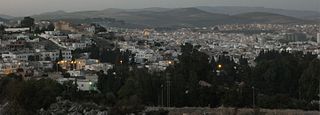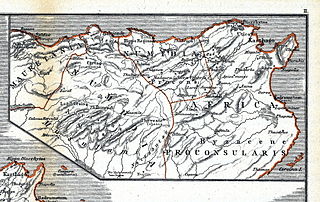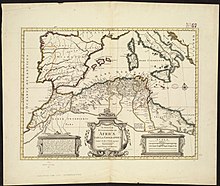
Byzacena was a Late Roman province in the central part of Roman North Africa, which is now roughly Tunisia, split off from Africa Proconsularis.

Béja is a city in Tunisia. It is the capital of the Béja Governorate. It is located 105 kilometers (65 mi) from Tunis, between the Medjerdah River and the Mediterranean, against the foothills of the Khroumire, the town of Béja is situated on the sides of Djebel Acheb, facing the greening meadows, its white terraces and red roofs dominated by the imposing ruins of the old Roman fortress.

The name Early African Church is given to the Christian communities inhabiting the region known politically as Roman Africa, and comprised geographically somewhat around the area of the Roman Diocese of Africa, namely: the Mediterranean littoral between Cyrenaica on the east and the river Ampsaga on the west; that part of it that faces the Atlantic Ocean being called Mauretania, in addition to Byzacena. Thus corresponding somewhat to contemporary Morocco, Algeria, Tunisia and Libya. The evangelization of Africa followed much the same lines as those traced by Roman civilization.
Sidi Bouzid, sometimes called Sidi Bou Zid or Sīdī Bū Zayd, is a city in Tunisia and is the capital of Sidi Bouzid Governorate in the centre of the country. Following the suicide of Mohamed Bouazizi in Sidi Bouzid, it was the site of the first clashes of the Tunisian Revolution and a catalyst for other protests in the region, often known as the Arab Spring.
The Lex Manciana is a Roman law dealing with tenancy agreements of imperial estates in Roman North Africa.

Aggar was a town and bishopric in the Roman province of Byzacena. One of two cities in the area, it left vast ruins that are now called (Henchir) Sidi Amara. These edifices are situated in the plain of Siliana, around 60 kilometres east of Maktar.

Henchir-El-Hatba is a village and an archaeological site in Tunisia. It was a Roman Catholic diocese.

Djebba, also known as Thigibba Bure, is a town and an ancient archaeological site is located in Bājah, Tunisia. Djebba is an archaeological/prehistoric site in Tunisia located at latitude: 36°28'32.45" longitude: 9°4'53.54" in the Béja Governorate of northwestern Tunisia. The estimated terrain elevation above sea level is 355 metres located below the slopes of Djebel Gorra, 700 meters above sea level. Djebba also has a national park, which is the subject of a development project

Sidi Medien is a village in Zaghouan Governorate, Tunisia.

Vallitanus or Vallis was an ancient Roman–Berber colonia in Carthage, Tunisia. The town is identified with ruins at Sidi Medien, where are located the remains of a Roman theatre, and a number of Roman inscriptions bearing witness to the town's name, and some local officials of the time can be found near the theatre.
Avioccala was a Roman and Byzantine era town in the Roman province of Africa Proconsularis in northern Tunisia. The town lasted from 30BC to about 640AD, and has been tentatively identified with the stone ruins at Sidi-Amara, Tunisia.

Aeliae or Æliæ was a Roman-era city in the province of Byzacena.

Dzemda is a locality in Tunisia.

Henchir Bez is an archaeological site in Tunisia, located at 36° 00′ 23″ N, 9° 32 in the hills overlooking the Oued Miliane river, west of Tunis. Identified by a recently discovered inscription, it is the ruins of the Roman civitas of Vazi Sarra, which include a Christian Basilica and a Byzantine/Roman fort.
Henchir Chigarnia is an Archaeological site in Tunisia. It is identified with ruins near the modern town of Enfidha, Tunisia and represents a former Roman town of the province of Africa Proconularis.
Oued Sidi Salah is a wadi of eastern Tunisia. It rises in the hinterland behind the city of Sfax and empties into the Chott El Merdasia near Sidi Mansour, on the Mediterranean coast. The wadi takes its name from Dar Mahommed Salah which it flows past.

The Diocese of Dices, is a titular see of the Roman Catholic Church. The location of the seat of the diocese is unknown for certain, but is perhaps identifiable with Henchir-Sidi-Salah, Tunisia. Henchir Sidi Salah was an ancient diocese in the Roman-Berber province of Byzacena.
Bir el Menadla is a locality and archaeological site in Governorate de Mahdia, Tunisia.

Numidia was a Roman province on the North African coast, comprising roughly the territory of north-east Algeria.
Sidi Salah can refer to the following places in Tunisia:











